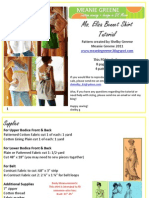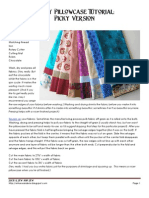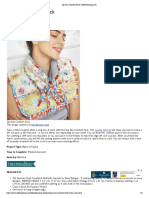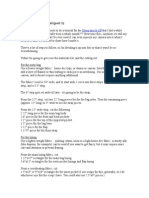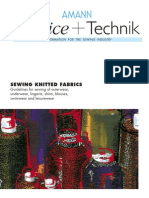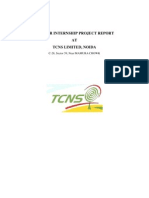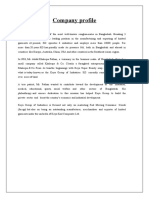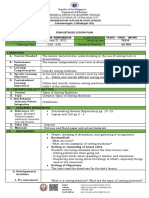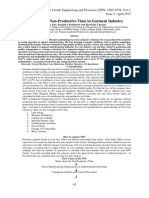Handicap Clothing Conversion
Handicap Clothing Conversion
Uploaded by
accessaudioCopyright:
Available Formats
Handicap Clothing Conversion
Handicap Clothing Conversion
Uploaded by
accessaudioCopyright
Available Formats
Share this document
Did you find this document useful?
Is this content inappropriate?
Copyright:
Available Formats
Handicap Clothing Conversion
Handicap Clothing Conversion
Uploaded by
accessaudioCopyright:
Available Formats
Convert a Day Dress into an Open Back Dress
for Handicap and Geriatrics
A standard commercial made assisted dressing dress generally has a double wrapped back . But we are going to
convert a pre -owned off the rack dress, (maybe a patients favorite) so that the wearer can feel comfortable in
their own clothes. This process will work for slips, shirts and sleepwear as well.
Commercial Ours
Materials:
TOOLS
sewing machine
Measuring tape
Pins
Fabric Scissors
Pencil
Newsprint or something large to trace your panel patterns onto.
ruler/yard stick
FABRIC AND NOTIONS
Single fold bias binding to match color of dress (You will have to decide how much after you measure)
Piece of solid cotton fabric, pre-shrunk, that is the same color as the dress and is as long as, and half as wide as
the dress.
3- Buttons that matches the dress that are very flat, very smooth and not too big
3- 3/4 inch length pieces of 1/8 inch elastic
© Charlene Tremain Morrison www.thatssimplyfineandfancy.blogspot.com
Start:
If there is a center back seam , just undo the seam with a stitch ripper carefully. You don't want to loose
any fabric. If there is no center seam, find the exact center back of the dress by measuring from side
seams and mark with pins from top to bottom. Carefully cut along your pin line to the top of the dress,
Including any neck facing. Tack any neck facing down to the cut edge so that it will be sewn into the
dress.
Left Side of Dress: Inside Panel piece
• Design your inside panel piece by measuring a)the back of the dress from the underarm seam up to the
neck line, ¼ of an inch away from the newly cut edge. b) the center back from op to bottom c) the side
seam from under arm to hem edge and d) side seam to center edge at hem.
Calulations example for a straight hanging dress:
Under arm to neck _________ and extend ¼ inch horizontally from neck point
and extend ½ inch horizontally from underarm point
underarm to hem edge: _________ + ½ inch = __________
Center back to center hem _________ + ½ inch = __________
Side seam @ hem to hem at center cut _________ + ¾ inch = __________
© Charlene Tremain Morrison www.thatssimplyfineandfancy.blogspot.com
But most likely you have a shaped dress.....
Open the now cut dress up onto your pattern paper and pin down the back piece of the dress that you want to
copy. Place pins at a) the underarm seam
b) the neck
c) the center cut hem
d) the side seam hem
• Trace with a pencil across the bottom hem line from pin to pin
• Trace from bottom hem line up to top hem line
• Trace from bottom hem line up to under arm seam.
Unpin dress from paper and with a ruler match the neck point with the underarm point. Now you need to add
your seam allowance. On the angled edge from neck to underarm , you will fold over a piece of bias binding the
same length, no extra length is needed
Sewing
• Fold and iron the bias tape piece in half length wise. Sew the Bias tape across the top of the fabric on
the neck to arm edge with a standard sewing method.
• Hem the side seam edge with a double fold hem, folding ¼ inch twice.
• Repeat hem instructions for bottom hem.
© Charlene Tremain Morrison www.thatssimplyfineandfancy.blogspot.com
Pin this new panel to the left side of the dress back at the raw edges with right sides of fabric facing together .
• Sew together from top to bottom. Press seam flat. Finish the seam with a zig zag stitch, serged edge or
pinking sheers. At the neck edge, fold the raw edge of this new seam inwards towards the seam and tack
down. Sew a button onto the seam line at the neck (using the seam as a reinforcement) also place a
button in the same way at the waist level of the dress.
• Sew third button to the under arm inside seam corner.
Right Side of Dress:
• Fold and place ¾ in pieces of 1/8 inch elastic onto the raw center edge of dress and tack into place.
These become the loops for your buttons. (You may have to adjust the length of the loops, as you don't
want the buttons to undo easily.)
• Pin the bias binding down the length of the center back of the dress, right sides together and ¼ inch
selvage on each end of bias tape for folding up. Sew through entire length with a ¼ inch (or less) seam
allowance..
• Open new seam and turn bias tape to the inside of the dress fabric and iron flat. Fold in end salvages and
iron flat. No bias tape should be seen from outside the dress. Pin into place and then sew from top to
bottom.
• Tack down folded bias tape ends with a whip stitch to the dress.
• Place 3rd piece of elastic on the inside under arm side seam and sew into place
© Charlene Tremain Morrison www.thatssimplyfineandfancy.blogspot.com
Skirts or Dresses with a Defined Waist or Commode Accessibility
A) The basic directions are the same, except you will only cut up to the waist line.
B) Sew a reinforcement stitch across the top of where you stopped cutting, or sew in a small square of fabric to
the underside of the dress in the same spot, sewing a box shape and two crossing diagonals.
C)Your panel will measure straight across to the side seam from the center seam/cut instead of measuring the
diagonal from neck to under arm.
D)I would also suggest that the Right center cut edge be covered in double fold bias tape so no fabric will be
lost, that would cause a gap in the the center back. Don't for get to fold the edges of the tape inside so you have
a finished edge. Only one button loop would be needed which is attached at the side seam.
A B C D
© Charlene Tremain Morrison www.thatssimplyfineandfancy.blogspot.com
You might also like
- Snuggler CatDocument28 pagesSnuggler Catjanne.vesiroos100% (8)
- Vogue's Book of Smart Dressmaking 1948 PDFDocument66 pagesVogue's Book of Smart Dressmaking 1948 PDFNagyBoglárka100% (10)
- Boy's Vest Tutorial With PDF PatternDocument17 pagesBoy's Vest Tutorial With PDF Patternninagika100% (1)
- Grade 9 TLE-SP - Dressmaking 2nd QuarterDocument9 pagesGrade 9 TLE-SP - Dressmaking 2nd QuarterMike Clyde AlimaNo ratings yet
- HVP 90 Manual EnglishDocument22 pagesHVP 90 Manual EnglishLuis Caba Ramirez88% (17)
- Vestido TranspassadoDocument14 pagesVestido TranspassadoEunicia Andrade100% (1)
- Ms Eliza Bennet Shirt Tutorial 2011Document12 pagesMs Eliza Bennet Shirt Tutorial 2011Shelby GreeneNo ratings yet
- Sewing Instructions - Green DressDocument11 pagesSewing Instructions - Green DressNostalgia234100% (1)
- Sidonie Variation 1 OriginalDocument9 pagesSidonie Variation 1 Originalalessyana100% (1)
- Just for You: Selfish Sewing Projects from Your Favorite SewCanShe BloggersFrom EverandJust for You: Selfish Sewing Projects from Your Favorite SewCanShe BloggersNo ratings yet
- Sewing in No Time: 50 step-by-step weekend projects made easyFrom EverandSewing in No Time: 50 step-by-step weekend projects made easyRating: 5 out of 5 stars5/5 (1)
- Daisy Blouse Template: Print OUT & KeepDocument18 pagesDaisy Blouse Template: Print OUT & KeepRushika GunasekeraNo ratings yet
- Templates Mit8Document83 pagesTemplates Mit8Maria RodriguezNo ratings yet
- Faviola, The "Housewife" Summer Dress Tutorial: You Can Read More About This Pattern Over at So Sew EasyDocument35 pagesFaviola, The "Housewife" Summer Dress Tutorial: You Can Read More About This Pattern Over at So Sew EasyGede Adél-JúliaNo ratings yet
- Fancy Pillowcase TutorialDocument5 pagesFancy Pillowcase TutorialElizabethNo ratings yet
- Andika Shirt Sewing InstructionsDocument22 pagesAndika Shirt Sewing InstructionsAnonymous tIhcNRlpSnNo ratings yet
- Collection PDFDocument132 pagesCollection PDFmensapertaNo ratings yet
- Pattern Download: ISSUE 151 JULY 2021Document30 pagesPattern Download: ISSUE 151 JULY 2021Jose Sanchez100% (2)
- Ruffle Sleeve Top - Free Sewing Patterns - Sew MagazineDocument7 pagesRuffle Sleeve Top - Free Sewing Patterns - Sew MagazineMornisa MagisperanNo ratings yet
- Assembly Guide: Nashville (Girls 9m - 20) - A4 FormatDocument34 pagesAssembly Guide: Nashville (Girls 9m - 20) - A4 FormatWilkins CharlseNo ratings yet
- Spa Day Comfort Pack - AllFreeSewingDocument4 pagesSpa Day Comfort Pack - AllFreeSewingnone0% (1)
- Gardening Tool Belt PayhipDocument13 pagesGardening Tool Belt PayhipElizabeth CroweNo ratings yet
- Olivia's Best Dress InstructionsDocument1 pageOlivia's Best Dress InstructionsemilytaylordesignNo ratings yet
- Blusa Con Pechera de Tachones 6009 BurdaStyle Patron T38 Instrucciones InglesDocument19 pagesBlusa Con Pechera de Tachones 6009 BurdaStyle Patron T38 Instrucciones InglesLuneralu100% (1)
- Beach Dress Revised PayhipDocument32 pagesBeach Dress Revised PayhipmaniraptorNo ratings yet
- Brennas Bubble Pocket ShortsDocument16 pagesBrennas Bubble Pocket ShortsLinh KurtNo ratings yet
- 6025 Női Nadrág 46-60 PDFDocument44 pages6025 Női Nadrág 46-60 PDFGyöngyösi-Zeke Anikó100% (3)
- Twirly Dress Combined File 2 Files Smaller and Larger Sizes From Nap-Time CreationsDocument41 pagesTwirly Dress Combined File 2 Files Smaller and Larger Sizes From Nap-Time CreationsddNo ratings yet
- Easy Pleated Skirt Craftsy PDFDocument20 pagesEasy Pleated Skirt Craftsy PDFAndrea TeiermayerNo ratings yet
- Let's Make A Pretty Zippered PouchDocument10 pagesLet's Make A Pretty Zippered Pouchmarah ketebeleceNo ratings yet
- Plus Size Pants Patterns Round Up - XLSX Sheet1 2Document26 pagesPlus Size Pants Patterns Round Up - XLSX Sheet1 2adi mer100% (1)
- So Sew Easy It's A Wrap' Top: Click HereDocument42 pagesSo Sew Easy It's A Wrap' Top: Click Heretikiti98No ratings yet
- How To Make A Quick & Easy Tabard or T-TunicDocument0 pagesHow To Make A Quick & Easy Tabard or T-TunicRochelle DeNo ratings yet
- Axolotl-Plush-Sewing-Pattern (2) 4Document20 pagesAxolotl-Plush-Sewing-Pattern (2) 42jjqhyksmsNo ratings yet
- So Sew Easy Graffiti DressDocument24 pagesSo Sew Easy Graffiti DressFesta infantil lembrancinhas100% (1)
- Free Project: Wrist BagDocument4 pagesFree Project: Wrist BagGina SeptianiNo ratings yet
- Sewers Guide PDFDocument12 pagesSewers Guide PDFLogan Mckee100% (2)
- Anna Dress PDF PatternDocument12 pagesAnna Dress PDF PatternCeleste PimperNo ratings yet
- Classic Polka Dot Dress - Free Sewing PatternsDocument4 pagesClassic Polka Dot Dress - Free Sewing Patternspurplravioli8065No ratings yet
- Mod Diaper Bag Tutorial2Document9 pagesMod Diaper Bag Tutorial2monica100% (1)
- R48Pattern Dress Top Bloomer3M 3TDocument16 pagesR48Pattern Dress Top Bloomer3M 3Tmariarod100% (1)
- SewStylish Magazine Free Pocket PatternDocument1 pageSewStylish Magazine Free Pocket PatternAditi100% (1)
- QA-GiftsFreemium - v6 FINAL PDFDocument16 pagesQA-GiftsFreemium - v6 FINAL PDFsivathmigaNo ratings yet
- Burda Face Mask Sewing Pattern 125c0a8Document6 pagesBurda Face Mask Sewing Pattern 125c0a8Jean100% (1)
- Itch To Stitch Lago Tank PDF Sewing Pattern Large Format V2 61d95faa684f7Document1 pageItch To Stitch Lago Tank PDF Sewing Pattern Large Format V2 61d95faa684f7Berit Gullholm MarkussenNo ratings yet
- Cecilia-Puff-Tee-Final-OUSM-Designs-12 MESES A TALLA 8Document19 pagesCecilia-Puff-Tee-Final-OUSM-Designs-12 MESES A TALLA 8Jose SanchezNo ratings yet
- Faviola, The "Housewife" Summer Dress Tutorial: You Can Read More About This Pattern Over at So Sew EasyDocument35 pagesFaviola, The "Housewife" Summer Dress Tutorial: You Can Read More About This Pattern Over at So Sew EasyMornisa Magisperan0% (1)
- Retro Curtain ShowerDocument6 pagesRetro Curtain ShowerJjffjj Kojgff100% (1)
- The Hostess Apron Comeback Series - #5 - Romantic Cottage Style - Sew4HomeDocument13 pagesThe Hostess Apron Comeback Series - #5 - Romantic Cottage Style - Sew4HomeMareş GeorgetaNo ratings yet
- Messenger Bag TutorialDocument22 pagesMessenger Bag Tutorialczerjyo100% (2)
- Benjamins Polo ShirtDocument23 pagesBenjamins Polo ShirtekeninomimNo ratings yet
- Sew Halloween Pattern Cape PDFDocument4 pagesSew Halloween Pattern Cape PDFStefaniaRosatiNo ratings yet
- Please Refer To Mimi & Tara For The Sewing Instructions For This Dog Shirt Pattern atDocument8 pagesPlease Refer To Mimi & Tara For The Sewing Instructions For This Dog Shirt Pattern atRicardo OmarNo ratings yet
- Instructions Peppermint Wrap Skirt in The FoldsDocument19 pagesInstructions Peppermint Wrap Skirt in The FoldsDiana BogdanNo ratings yet
- Classic Man Boxer Shorts Pattern PayhipDocument13 pagesClassic Man Boxer Shorts Pattern PayhipSSmith's ContractingNo ratings yet
- Tiny TrophyDocument4 pagesTiny TrophyAi Mortz100% (1)
- Manual Singer 3333Document102 pagesManual Singer 3333br0k3n_boiyNo ratings yet
- Sewing Knitted FabricsDocument12 pagesSewing Knitted Fabricsapi-26494555No ratings yet
- Aladdin Crochet PatternDocument34 pagesAladdin Crochet Patternfesabe9040100% (1)
- Garment Manufacturing Process: From Fabric To Finished Apparel ProductsDocument22 pagesGarment Manufacturing Process: From Fabric To Finished Apparel ProductsISHITA100% (1)
- DLL TLE Week3Document6 pagesDLL TLE Week3Jepoy Macasaet100% (1)
- Apparel Internship Report TCNS Limited NoidaDocument50 pagesApparel Internship Report TCNS Limited NoidaDivya Singla100% (2)
- Sultana InternshipDocument75 pagesSultana InternshipBatch 27No ratings yet
- 2007 PIA-Sewing-WSDocument16 pages2007 PIA-Sewing-WSMike CryerNo ratings yet
- Brother Serger Manual (Handbook For Compact Overlock Machine)Document72 pagesBrother Serger Manual (Handbook For Compact Overlock Machine)Christian Jensen IVNo ratings yet
- Pattern Pieces For A Sari Blouse: Salwar Kameez SewingDocument39 pagesPattern Pieces For A Sari Blouse: Salwar Kameez SewingNi Vi100% (2)
- Needlecraft: Learner'S MaterialDocument13 pagesNeedlecraft: Learner'S MaterialLorry Manuel100% (1)
- Q3-4-G8-Lesson-Plan DressmakingDocument4 pagesQ3-4-G8-Lesson-Plan DressmakingRhoda RenomeronNo ratings yet
- Taping and Pad StitchingDocument5 pagesTaping and Pad StitchingChenyi WeiNo ratings yet
- Plant Layout (Amrita)Document16 pagesPlant Layout (Amrita)Anonymous a8PZKyJxNo ratings yet
- Guide Des Tailles Kariban Brands 2023Document1 pageGuide Des Tailles Kariban Brands 2023tomkar2109No ratings yet
- Quilt BrochureDocument2 pagesQuilt Brochurekatelynvest773176100% (1)
- Zoje ZJ9701 (NEW)Document47 pagesZoje ZJ9701 (NEW)Williams GonzalezNo ratings yet
- AbrilDocument24 pagesAbrilnipokio86% (7)
- 2419 General Directions: Cutting/Marking The PatternDocument4 pages2419 General Directions: Cutting/Marking The PatterndidomessiNo ratings yet
- To Reduce Non-Productive Time in Garment IndustryDocument5 pagesTo Reduce Non-Productive Time in Garment Industryabebe adgoNo ratings yet
- Durene Jones DJE 1059 - Autumn Fox OrnamentDocument13 pagesDurene Jones DJE 1059 - Autumn Fox OrnamentkittikoposdiNo ratings yet
- Winged Hair Clips Sewing PatternDocument5 pagesWinged Hair Clips Sewing PatternJullyanny BinottiNo ratings yet
- Business PlanDocument22 pagesBusiness PlanAngelica BatiquinNo ratings yet






